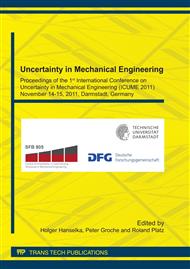[1]
Mitchell, M.R.: Fundamentals of Modern Fatigue Analysis for Design, in: ASM Handbook, Ed. Steven R. Lampman, ASM International, Materials Park, 1996, pp.229-249.
Google Scholar
[2]
Rice, R.C.; Leis, B.N.; Berns, H.D.; Nelson, D.V.; Lingenfleser, D. and Mitchell, M.R.: Fatigue Design Handbook, SAE, Warrendale, 1988, 369 ps.
Google Scholar
[3]
Sonsino C.M.: Fatigue testing under variable amplitude loading, International Journal of Fatigue, 29(6), 2007, pp.1080-1089.
DOI: 10.1016/j.ijfatigue.2006.10.011
Google Scholar
[4]
Niesłony A.: Rain flow counting method, set of functions with user guide for use with MATLAB, Information on áhttp: /www. mathworks. com/matlabcentral/fileexchange/3026ñ.
Google Scholar
[5]
Basquin O.H.: The exponential law of endurance tests, Am. Soc. Test. Mater. Proc., Vol. 10, 1910, pp.625-630.
Google Scholar
[6]
Manson S.S.: Fatigue: a complex subject - some simple approximation. Experimental Mechanics, Vol. 5, 1965, pp.193-226.
Google Scholar
[7]
Coffin L.F.: A study of the effect of cyclic thermal stresses on a ductile metal, Trans ASME, Vol. 76, 1954, pp.931-950.
DOI: 10.1115/1.4015021
Google Scholar
[8]
Manson S.S., Halford G.R.: Fatigue and Durability of Structural Materials, ASM International, Materials Park, Ohio, 2006, 456 ps.
Google Scholar
[9]
Kocańda S.: Fatigue Failure of Metals, Springer-Verlag GmbH, 1978, 388 ps.
Google Scholar
[10]
Macha E. and Sonsino C.M.: Energy criteria of multiaxial fatigue failure, Fatigue Fract Engng Mater Struct, 22, 1999, pp.1053-1070.
DOI: 10.1046/j.1460-2695.1999.00220.x
Google Scholar
[11]
Jahed H. and Varvani-Farahani A.: Upper and lower fatigue life limits model using energy-based fatigue properties, International Journal of Fatigue, Volume 28, Issues 5-6, 2006, pp.467-473.
DOI: 10.1016/j.ijfatigue.2005.07.039
Google Scholar
[12]
Smith K.N., Watson P. and Topper T.H.: A stress strain function for the fatigue of metals, J. Materials, Vol. 5, 1970, pp.767-776.
Google Scholar
[13]
ASTM Standard E606-92: Standard practice for strain-controlled fatigue testing. In: Annual book of ASTM standards, Vol. 03. 01. ASTM; 1997, pp.523-37.
Google Scholar
[14]
Bäumel A. and Seeger T.: Material Data for Cyclic Loading, Materials Science Monographs, 61, Elsevier Science Publishers, Amsterdam, (1990).
Google Scholar
[15]
Ramberg W. and Osgood W.R.: Description of stress-strain curves by three parameters, Technical Note No. 902, National Advisory Committee for Aeronautics, Washington DC, (1943).
Google Scholar
[16]
Plumtree A. and Abdel-Raouf H.A.: Cyclic stress–strain response and substructure, International Journal of Fatigue, Vol. 23, 2001, pp.799-805.
DOI: 10.1016/s0142-1123(01)00037-8
Google Scholar
[17]
Niesłony A., El Dsoki Ch., Kaufmann H., Krug P.: New method for evaluation of the Manson-Coffin-Basquin and Ramberg-Osgood equations with respect to compatibility, International Journal of Fatigue, Vol. 30, 2008, p.1967-(1977).
DOI: 10.1016/j.ijfatigue.2008.01.012
Google Scholar
[18]
Niesłony A., Kurek A., El Dsoki Ch. and Kaufmann H.: A study of compatibility between two classical fatigue curve models based on some selected structural materials, International Journal of Fatigue, 2011, Available online doi: 10. 1016/j. ijfatigue. 2011. 03. 002.
DOI: 10.1016/j.ijfatigue.2011.03.002
Google Scholar


